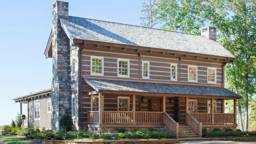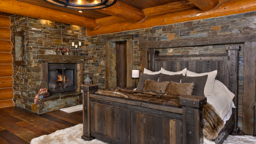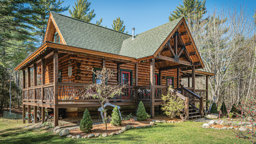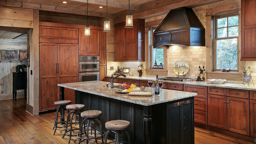
Photo: Adobe Stock ©JenkoAtaman
Over the past 25 years, I’ve been lucky to have traveled all over the United States while making my living in the log and timber home business. I’ve met a lot of fantastic people, seen countless beautiful homes and, hopefully, helped those homeowners fulfill their dreams.
But I have to say — I have never seen anything quite like the recent phenomenon I am seeing right now. The combination of the Covid-19 fears (and a newfound ability to telework) coupled with civil unrest in many large cities has caused countless urban dwellers to flock to the country. All my customers who manufacture log and timber homes are telling me that they have had more activity and sold more homes this spring and summer than at any time since before the Great Recession. This is good news for manufacturers and builders, as well as the hundreds of building materials suppliers who service our industry — but it may present some challenges for buyers.
For anyone who either wants to move to “the country” permanently or is looking for a second-home as a refuge to escape urban stress, I would like to take a moment to offer a little insight, or at least to let you know what to expect.
Be patient. Don’t expect to be able to simply walk into a log or timber manufacturer on any given day and then be able to move into your home in a few brief months. There are already backlogs in these companies’ production schedules, as well as a shortage of available builders.
Also, unless you purchase an existing plan, there will be time spent in design, drafting and permitting — and all of this assumes that you have a piece of land to build your new home on. This entire process is going to take about a year to complete, so don’t rush.
If you’re working with a local log or timber home producer, listen to their team’s advice on design, materials, builders and properties. They have probably been doing business in that area for many years and they understand what works best on a local basis.
Thoughtfully choose the area where you want to live. In times like these, it’s easy to make a snap decision, but be sure to do your research. First, think about your daily life, and determine if/how your prospective homesite can accommodate your needs.
Do you plan to work from your new cabin in the country? Better check out internet speeds/costs and cell service, as well as UPS or FedEx shipping facilities.
How is your health? What kind of medical facilities are readily available? If these facilities are lacking, you may want to look into insurance which would cover helicopter ambulance services.
Are you going to spend the winter at your new home? Better check out the accessibility to it after it snows. That mountain-top view will be tough to see from the bottom of your driveway.
Think ahead. Make sure your home will suit your family’s future, as well as your current needs. You may be a 50-year-old couple with two kids in college now, but, in the not too distant future, you may be wondering where your grandchildren are going to sleep when they visit. If you are a little older, look at the accessibility of your new home. Is it a single or two-story design? Are there stairs to navigate from the driveway? Is there room for an elevator or dumbwaiter? Is the master bedroom on the first floor? If you’re building your dream home, do everything you can to ensure it will work for you forever.
If you’re looking at buying an existing log or timber home, I highly suggest that you have a professional wood-home restoration company (or companies) inspect the structure. These companies can give you an assessment of the condition of the house, what they would do to the home prior to you moving in and what it might cost to maintain the it on an annual basis. (This would be in addition to a general assessment by a regular home inspector.) You often can use the inspector’s findings during negotiations to buy the property.
What are the most affordable places to buy real estate in the U.S.?
A 2020 study published by Refi Guide says that these 20 states offer the biggest bang for your housing buck — and they are ripe for log & timber home living.
- Mississippi
- Ohio
- Oklahoma
- Michigan
- Illinois
- Indiana
- Texas
- Arkansas
- Pennsylvania
- Georgia
- Wisconsin
- Alabama
- Iowa
- Missouri
- Kansas
- Nebraska
- Minnesota
- North Carolina
- Alaska
- Louisiana
The Log and Timber Home Plunge - Now's the Time
As the longtime VP of Sales & Marketing for Tennessee-based StoneMill Log & Timber Homes, Mathew Sterchi says he’s seeing a growing number of urban refugees from places like New York, New Jersey, Illinois and California who are tired of living in congested big cities and the high costs associated with them. They’re looking to move to rural areas with lower taxes, a slower pace and a better quality of life. States like Pennsylvania, North Carolina, Texas and Idaho provide the combination of affordability, amenities and elbow room people are searching for.
“Here in Tennessee, we are seeing a huge influx of people moving from the Northeast and upper Midwest,” says Mathew. “I know that Texas is seeing a lot of people coming in from California.”
“Across the country, the number of houses for sale has dropped way down, and when you have that recipe of low supply and high demand like we have right now, prices on existing inventory goes up. As a result, the cost of preexisting homes are rivaling new home construction,” Mathew explains. This makes it a good time to take the custom log or timber home plunge. As Mathew says, “Who wouldn’t want to build something new, that’s designed specifically for them, if they had the chance?”





_11868_2023-12-20_08-12-256x288.jpg)





